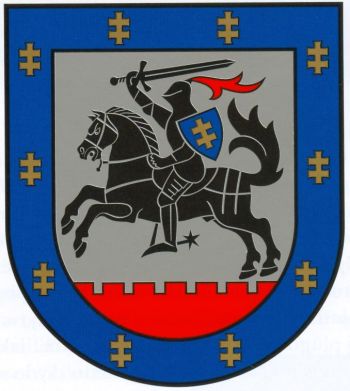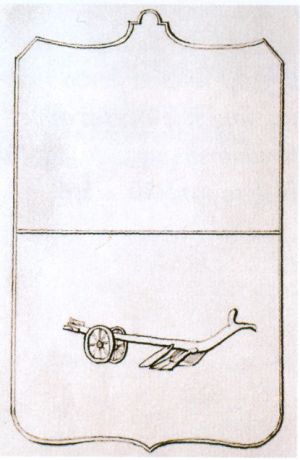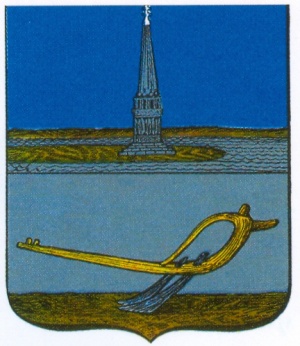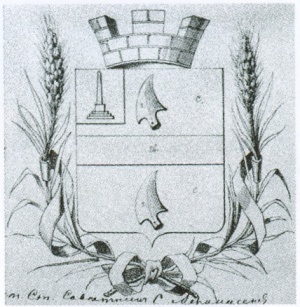Panevėžys (county): Difference between revisions
Knorrepoes (talk | contribs) (Created page with '{|width="100%" style="color:black; background-color:#ffffcc;" |width="15%"|50 px|left |width="70%" align="center" |'''Heraldry of the World<br/>Civic heral…') |
Knorrepoes (talk | contribs) m (Text replacement - "{{lt}}↵↵'''" to "'''") Tags: Mobile edit Mobile web edit |
||
| (19 intermediate revisions by the same user not shown) | |||
| Line 1: | Line 1: | ||
'''PANEVĖŽYS COUNTY''' | |||
[[File:panevezys county.jpg|center|350 px|Arms (crest) of {{PAGENAME}}]] | |||
{| class="wikitable" | |||
|+Official blazon | |||
|- | |||
|'''Lithuanian''' | |||
| blazon wanted | |||
|- | |||
|'''English''' | |||
| blazon wanted | |||
|} | |||
===Origin/meaning=== | |||
he arms were granted on July 7, 2004. | he arms were granted on July 7, 2004. | ||
The early origin of | The early origin of Panevėžys county is the ancient Upyte land. It became the local principality in the early 13th century and later (probably in the mid 14th century) was incorporated into Trakai duchy. However Upyte remained the significant administrative center, and the "Upyte land" has not disappeared from the documents. The Upyte itself was not growing, and the administration of land moved first to Ramygala and later to Panevėžys. | ||
In 1564 the Upyte district (pavietas) was established inside the Trakai province. Its administrative center was the | |||
In 1564 the Upyte district (pavietas) was established inside the Trakai province. Its administrative center was the [[Panevėžys (city)|Panevėžys]] city, but the name was kept for the tradition. | |||
The district used the seals with National Arms. Their design was copied from the State minor seal but simplified, and the horse had no horsecloth. | The district used the seals with National Arms. Their design was copied from the State minor seal but simplified, and the horse had no horsecloth. | ||
During the first decades of rule of Russian Empire, the seal with Russian eagle in the upper part and the Lithuanian knight in the lower part was used. | During the first decades of rule of Russian Empire, the seal with Russian eagle in the upper part and the Lithuanian knight in the lower part was used. | ||
After the uprising of 1831, the Upyte district was renamed to Panevezys district. | After the uprising of 1831, the Upyte district was renamed to Panevėžys district. | ||
In 1837 the governor of Vilnius province Dmitry Bantysh-Kamenski provided the first project of new arms of Panevezys district: the Vilnius province arms in the upper part and the plough in the lower part. The plough should symbolize the agriculture of district.<br> | |||
In 1844 the Panevėžys district was reassigned to the Kaunas province. The project was provided again, with the arms of Kaunas province in the upper part. The governor of Kaunas province Fedor Mirkovich wrote on the project: "Wooden plough instead of plough". | |||
Emperor Nicholas I granted the arms on April 6, 1845: in the upper part the obelisk (the arms of Kaunas province), and in the lower part on silver background the brown wooden plough with steel share. | Emperor Nicholas I granted the arms on April 6, 1845: in the upper part the obelisk (the arms of Kaunas province), and in the lower part on silver background the brown wooden plough with steel share. | ||
{|align="center" | |||
|align="center"|[[File:Panevezys 1844 project.jpg|center|300 px|Coat of arms (crest) of {{PAGENAME}}]] <br/>The project of 1844 | |||
|align="center"|[[File:Panevezys 1845.jpg|center|300 px|Coat of arms (crest) of {{PAGENAME}}]] <br/>The arms from 1845 | |||
|} | |||
In 1861 Bernhard Koehne provided the new project. He pointed up the wooden plough is not a heraldic figure, and proposed the silver arms with red bent and two black ploughshares. The arms of Kaunas province was moved to free corner. The arms had three-tower mural crown and the decoration of two golden wheat spikes, bent with the red Alexander strip. The crown and Alexander strip should symbolize the district, and spikes should symbolize the agriculture. | In 1861 Bernhard Koehne provided the new project. He pointed up the wooden plough is not a heraldic figure, and proposed the silver arms with red bent and two black ploughshares. The arms of Kaunas province was moved to free corner. The arms had three-tower mural crown and the decoration of two golden wheat spikes, bent with the red Alexander strip. The crown and Alexander strip should symbolize the district, and spikes should symbolize the agriculture. | ||
{|align="center" | |||
|align="center"|[[File:Panevezys 1861 project.jpg|center|300 px|Coat of arms (crest) of {{PAGENAME}}]] <br/>The project of 1861 | |||
|} | |||
Though more heraldic, this project was not confirmed. The arms of 1845 was used till 1915. | Though more heraldic, this project was not confirmed. The arms of 1845 was used till 1915. | ||
When the Republic of Lithuania has established the Panevezys municipality, it modified the arms: instead of obelisk two crossed sheaves of linen were shown in the upper part. First time the plough was shown in the lower part, but soon the wooden plough went back to arms. | When the Republic of Lithuania has established the Panevezys municipality, it modified the arms: instead of obelisk two crossed sheaves of linen were shown in the upper part. First time the plough was shown in the lower part, but soon the wooden plough went back to arms. | ||
In 1969 these arms were granted to the | In 1969 these arms were granted to the Panevėžys city. | ||
In 1993 the city got back its own old symbol (the mural gate), and the arms of 19-20th centuries were granted to Panevezys district. | In 1993 the city got back its own old symbol (the mural gate), and the arms of 19-20th centuries were granted to Panevezys district. | ||
Discussing the arms for the | Discussing the arms for the Panevėžys county, the heraldry commission decided coming back not to the arms of 1845 but to the knight used in Upyte since the late 16th century. | ||
Also the | |||
The colors of | Also the Panevėžys city is considered the contemporary capital of Aukštaitija region, therefore both arms have the quite similar design, originating from the State minor seal of mid 16th century. | ||
The red mural line was added on the bottom, binding the county arms with the Upyte new arms. That symbolizes that | |||
The colors of Panevėžys | |||
county arms were changed to black knight on silver background, to differentiate it from the National Arms. | |||
The red mural line was added on the bottom, binding the county arms with the Upyte new arms. That symbolizes that Panevėžys county continues the tradition of Upyte district. | |||
{{lt}} | |||
{{media}} | {{media}} | ||
[[Literature]] : Information and image provided by Virginijus Misiunas, Vilnius. | [[Civic Heraldry Literature - Lithuania|'''Literature''']]: Information and image provided by Virginijus Misiunas, Vilnius. | ||
| Line 45: | Line 68: | ||
[[Category:Granted 2004]] | [[Category:Granted 2004]] | ||
[[Category:Panevėžys]] | [[Category:Panevėžys]] | ||
[[Category:Granted 1845]] | |||
Latest revision as of 06:53, 24 March 2024
PANEVĖŽYS COUNTY
| Lithuanian | blazon wanted |
| English | blazon wanted |
Origin/meaning
he arms were granted on July 7, 2004.
The early origin of Panevėžys county is the ancient Upyte land. It became the local principality in the early 13th century and later (probably in the mid 14th century) was incorporated into Trakai duchy. However Upyte remained the significant administrative center, and the "Upyte land" has not disappeared from the documents. The Upyte itself was not growing, and the administration of land moved first to Ramygala and later to Panevėžys.
In 1564 the Upyte district (pavietas) was established inside the Trakai province. Its administrative center was the Panevėžys city, but the name was kept for the tradition.
The district used the seals with National Arms. Their design was copied from the State minor seal but simplified, and the horse had no horsecloth. During the first decades of rule of Russian Empire, the seal with Russian eagle in the upper part and the Lithuanian knight in the lower part was used.
After the uprising of 1831, the Upyte district was renamed to Panevėžys district.
In 1837 the governor of Vilnius province Dmitry Bantysh-Kamenski provided the first project of new arms of Panevezys district: the Vilnius province arms in the upper part and the plough in the lower part. The plough should symbolize the agriculture of district.
In 1844 the Panevėžys district was reassigned to the Kaunas province. The project was provided again, with the arms of Kaunas province in the upper part. The governor of Kaunas province Fedor Mirkovich wrote on the project: "Wooden plough instead of plough".
Emperor Nicholas I granted the arms on April 6, 1845: in the upper part the obelisk (the arms of Kaunas province), and in the lower part on silver background the brown wooden plough with steel share.
| The project of 1844 |
The arms from 1845 |
In 1861 Bernhard Koehne provided the new project. He pointed up the wooden plough is not a heraldic figure, and proposed the silver arms with red bent and two black ploughshares. The arms of Kaunas province was moved to free corner. The arms had three-tower mural crown and the decoration of two golden wheat spikes, bent with the red Alexander strip. The crown and Alexander strip should symbolize the district, and spikes should symbolize the agriculture.
| The project of 1861 |
Though more heraldic, this project was not confirmed. The arms of 1845 was used till 1915.
When the Republic of Lithuania has established the Panevezys municipality, it modified the arms: instead of obelisk two crossed sheaves of linen were shown in the upper part. First time the plough was shown in the lower part, but soon the wooden plough went back to arms.
In 1969 these arms were granted to the Panevėžys city.
In 1993 the city got back its own old symbol (the mural gate), and the arms of 19-20th centuries were granted to Panevezys district.
Discussing the arms for the Panevėžys county, the heraldry commission decided coming back not to the arms of 1845 but to the knight used in Upyte since the late 16th century.
Also the Panevėžys city is considered the contemporary capital of Aukštaitija region, therefore both arms have the quite similar design, originating from the State minor seal of mid 16th century.
The colors of Panevėžys county arms were changed to black knight on silver background, to differentiate it from the National Arms.
The red mural line was added on the bottom, binding the county arms with the Upyte new arms. That symbolizes that Panevėžys county continues the tradition of Upyte district.
Lithuania heraldry portal
This page is part of the Lithuania heraldry portal |
Heraldry of the World |
|
Civic heraldry:
|
Other heraldry: |
Contact and Support
Partners:
Your logo here ?
Contact us
© since 1995, Heraldry of the World, Ralf Hartemink 
Index of the site
Literature: Information and image provided by Virginijus Misiunas, Vilnius.















